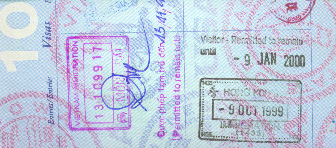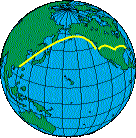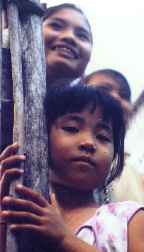.



|
|
To get to China from my home on the Potomac, you have to fly about 12,000 miles, crossing a dozen time zones in the process. This was going to be my sixth time flying west with the sun, the first time when I was 3-months old. My second trans-Pacific flight was at age five. In the early days, travelling by Lockheed Constellation, progress was much slower and the plane had to refuel on Guam. The pattern of day and night becomes strangely elongated in the process. Few things are as eerie in a child's mind as disembarking in the middle of the night to spend an hour or so in a dimly-lit quonset hut. Even at that hour the air was humid and furnace-room warm, a presentiment of our tropical destination. The artificial cycle caught up with me when we finally landed in Saigon around noon. So it was to bed in the early afternoon, only to wake at dusk with a strange vampiric sense of loss.
|
|
|
|
|

|
Things haven't changed all that much, though the jets are faster. So I started out from Washington National Airport at the comfortable time of 10 in the morning, on a familiar hop to Chicago, and thence to British Vancouver. There I had a three-hour layover with an additional delay of two hours, almost as if we were gathering ourselves for the great leap across the Pacific. Lolling around the airport, I was on the lookout for some of the others of our party. The travel maven at REI had mentioned that five of the 13 would be on the same flight from Vancouver. I wasn't wearing any lycra or other dead giveaways, and I didn't see anyone outfitted in that fashion, but I was found out nonetheless by Gail Thompson of Seattle. Gail was an active organizer, and quickly fingered Robert Beckman and Rachel Levy (also of Seattle).
|
|
 (photo by stephanie lin) |
It was somewhat comforting to already have some fellow travelers leaving the continent. It was to be a mere 13 hours across the Pacific to Hong Kong -- negligible compared to my Bali trip of a few years ago (30+ hours in all). The flight path took us up over Alaska, where the sun was still high in the sky, and I could look down on fantastic glaciers and ice-crusted islands. I napped and read and the hours passed quickly. Darkness on this 24-hour day finally fell as we approached Japan. In a couple of hours we were on the ground in Hong Kong, or Kowloon to be more precise, in the breezy warm night air. We laid in a little local currency for our brief stay -- the U.S. dollar exchanged for seven Hong Kong dollars. But in a couple of days, in China proper, we would be dealing in yuan. Our ad hoc group crammed into a small cab and took a long ride into town and the "BP International House." Though the name conjured up images of an informal traveler's hostel, this turned out to be a fairly modern hotel of a dozen or so stories. We were registered and up to our rooms in just a few minutes. Mine was unoccupied, though there was gear next to the beds indicating that my roommate had already checked in. I didn't know anything at all about Greg, but I was already finding out that the laconic environmental engineer from Las Vegas had tremendous energy that kept him constantly exploring.
|